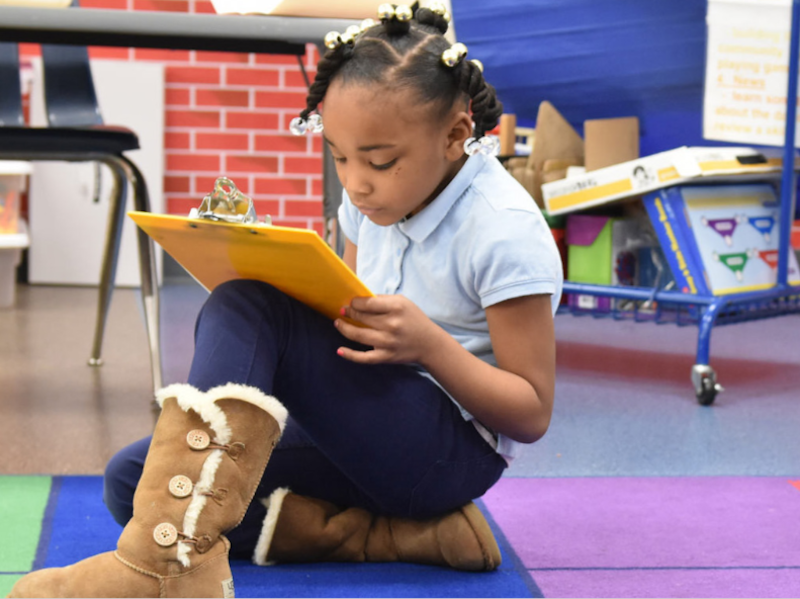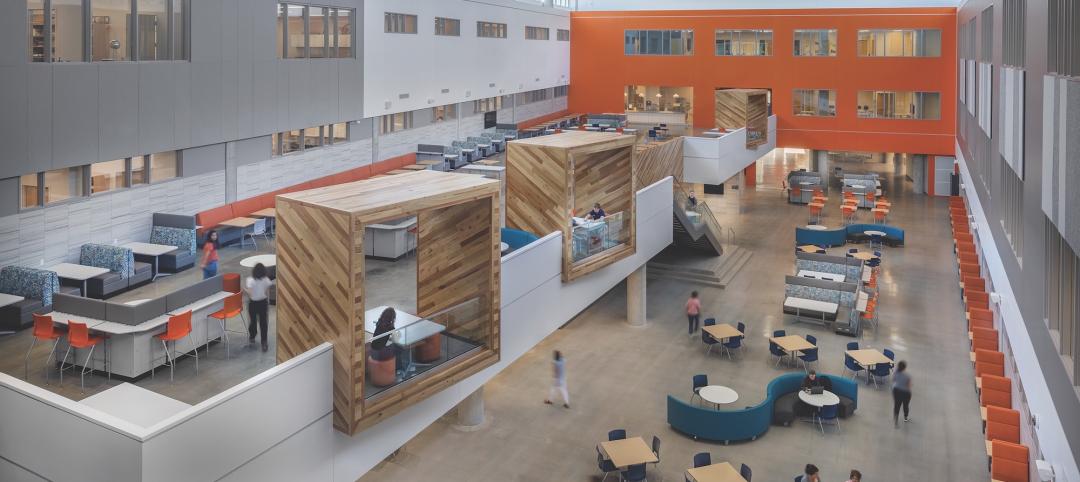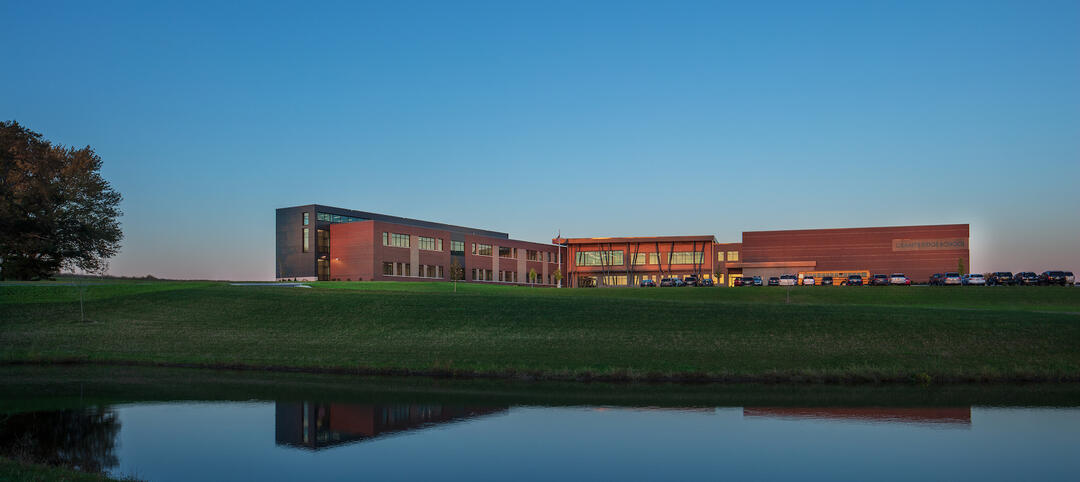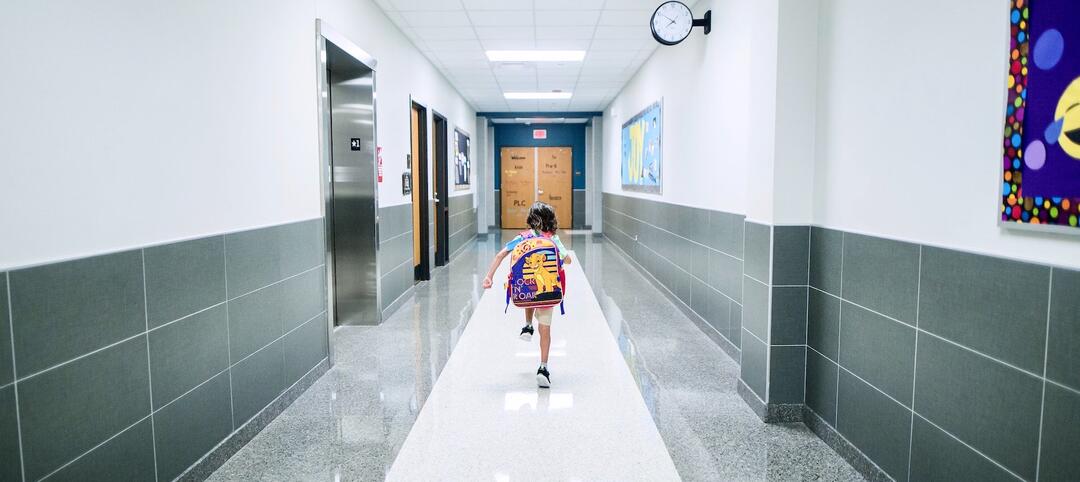It has been estimated that more than half of U.S. public schools need renovations or modernizations to be considered in good overall condition. The cost of bringing those schools up to par, though, could total nearly $200 billion.
Cash-strapped school districts that don’t have the funds to fix everything are searching for answers about where infrastructure improvements will have the greatest positive impact on students’ ability to learn and faculty’s ability to teach.
Earlier this year, Perkins Eastman partnered with the District of Columbia Public Schools on a study, cosponsored by J+J Flooring, to quantify the District’s modernization efforts. Since 2007, the District of Columbia Public Schools has invested more than $3 billion in school modernizations and improvements. Over the next six years, the District is committed to invest over $1 billion as part of its Capital Improvement Plan to modernize more school facilities.
During four consecutive weeks in February 2018, the Perkins Eastman study evaluated the level of satisfaction with Indoor Environmental Quality (IEQ)—daylight, thermal comfort, acoustics, and air quality—among occupants of nine elementary and middle public schools in the District: four that have been modernized within the last decade, and five that have had only minor improvements in the last 30 years.
The study intentionally excluded newly construction schools, and focused on younger students who are more vulnerable to environmental impacts because of their continued physical development and elevated respiratory rates.
Based on responses from four separate occupant questionnaires (whose response rate was 62% for students, 76% for faculty); on-site IEQ data collection using sensors, and school archival data on social influences, the paper reports that, in almost all IEQ factors, modernized schools saw improvements in both measured conditions and occupants’ satisfaction over non-modernized schools.
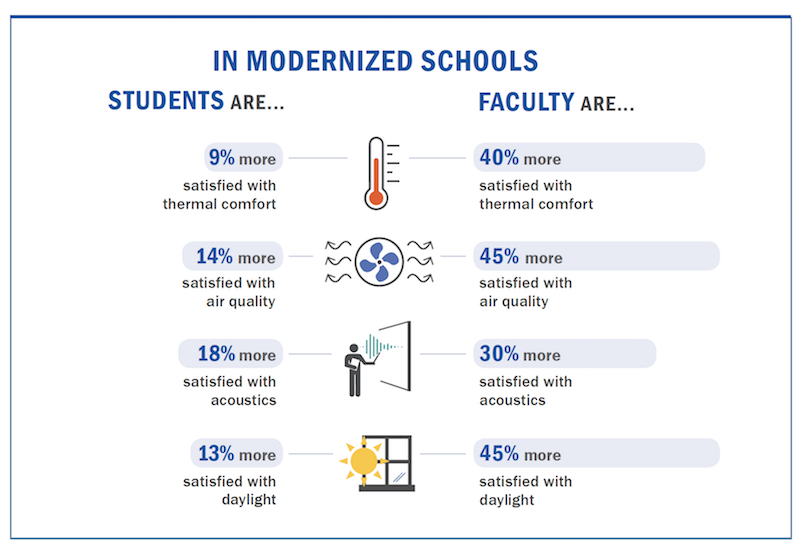
Perkins Eastman questioned students from Kindergarten to through 8th Grade, as well as faculty, and found significantly higher satisfaction levels with indoor environmental quality in modernized schools. Image: Perkins Eastman

Not surprisingly, daylight figures prominently on occupants’ satisfaction ratings. Various past surveys have found that students in classrooms with windows perform 20% faster on math tests and 26% faster on reading tests than students in windowless classroom.
For the Perkins Eastman study, two measures of daylight quality were examined in each room in both the morning and the afternoon: First, how well the daylight gets distributed throughout the entire classroom was studied using a light meter; and, second, the presence of glare or overlit conditions within classrooms was analyzed using calibrated cameras.
The results showed that the evaluated schools were generally more likely to be underlit (35%) than overlit (5%). However, schools across the study were well lit on average, with about 60% of the studied floor area meeting but not exceeding the LEED requirements for daylight autonomy and glare. The evaluated modernized schools were found to have marginally more well-lit areas than non-modernized schools
To evaluate the impact of acoustics, the study used a decibel meter to measure ambient noise levels over time. Readings showed that sound levels were 11% lower in modernized schools than in non-modernized ones. These readings likely indicate that modernizations lead to lower background noise levels due to improvements made to the mechanical systems and the building envelope to prevent infiltration of exterior noise.
However, when studying noise levels in occupied classrooms, the results showed high levels in all schools studied, regardless of whether they were recently modernized or not. These data reflect the dissatisfaction in the questionnaire responses that was found across the board with acoustics, and might indicate an issue that needs to be better addressed in modernization projects.

The amount of light in classrooms has a measurable impact on occupants' perceptions of their environment and ability to learn. Image: Perkins Eastman
To assess air quality, the study used a CO2 sensor to measure the effectiveness of ventilation. In the modernized schools, the results indicate that the median CO2 levels when occupied were 25% lower than in non-modernized schools.
The data show that modernized schools, on average, hit peak CO2 levels that were 41% lower than peak levels found in the non-modernized schools. This finding further reinforces the fact that modernized schools have improvements in ventilation effectiveness within classrooms, leading to better air quality for both students and teachers.
Lastly, this study used sensors and thermal cameras to track two aspects impacting thermal comfort: temperature of the classroom environments and thermal bridging of the building envelope. Temperatures within the evaluated modernized schools fell within ASHRAE’s comfort zone range of 68 to 75 degrees F 84% of the time. Non-modernized school fell within that range only 42% of the time
The peak temperatures of modernized schools were 4 degrees F lower than non-modernized schools, which the study found were overheated during winter months, peaking at 81 degrees F. “The non-modernized buildings may have less ability to control or deliver the appropriate amount of heat to an individual classroom space, resulting in overheating during the winter,” the paper suggests.
Related Stories
Education Facilities | Nov 30, 2022
10 ways to achieve therapeutic learning environments
Today’s school should be much more than a place to learn—it should be a nurturing setting that celebrates achievements and responds to the challenges of many different users.
K-12 Schools | Nov 30, 2022
School districts are prioritizing federal funds for air filtration, HVAC upgrades
U.S. school districts are widely planning to use funds from last year’s American Rescue Plan (ARP) to upgrade or improve air filtration and heating/cooling systems, according to a report from the Center for Green Schools at the U.S. Green Building Council. The report, “School Facilities Funding in the Pandemic,” says air filtration and HVAC upgrades are the top facility improvement choice for the 5,004 school districts included in the analysis.
Energy-Efficient Design | Nov 14, 2022
How to achieve net zero energy in five steps
Martine Dion and Ethan Seaman share net zero energy best practices with owners and developers.
K-12 Schools | Nov 1, 2022
Safety is the abiding design priority for K-12 schools
With some exceptions, architecture, engineering, and construction firms say renovations and adaptive reuse make up the bulk of their work in the K-12 schools sector.
BAS and Security | Oct 19, 2022
The biggest cybersecurity threats in commercial real estate, and how to mitigate them
Coleman Wolf, Senior Security Systems Consultant with global engineering firm ESD, outlines the top-three cybersecurity threats to commercial and institutional building owners and property managers, and offers advice on how to deter and defend against hackers.
Education Facilities | Oct 13, 2022
A 44-acre campus serves as a professional retreat for public-school educators in Texas
A first-of-its-kind facility for public schools in Texas, the Holdsworth Center serves as a retreat for public educators, supporting reflection and dialogue.
K-12 Schools | Sep 21, 2022
Architecture that invites everyone to dance
If “diversity” is being invited to the party in education facilities, “inclusivity” is being asked to dance, writes Emily Pierson-Brown, People Culture Manager with Perkins Eastman.
| Sep 7, 2022
K-8 school will help students learn by conducting expeditions in their own communities
In August, SHP, an architecture, design, and engineering firm, broke ground on the new Peck Expeditionary Learning School in Greensboro, N.C. Guilford County Schools, one of the country’s 50 largest school districts, tapped SHP based on its track record of educational design.
Giants 400 | Sep 1, 2022
Top 100 K-12 School Contractors and CM Firms for 2022
Gilbane, Core Construction, Skanska, and Balfour Beatty head the ranking of the nation's largest K-12 school sector contractors and construction management (CM) firms for 2022, as reported in Building Design+Construction's 2022 Giants 400 Report.
Giants 400 | Sep 1, 2022
Top 70 K-12 School Engineering + EA Firms for 2022
AECOM, Jacobs, WSP, and CMTA top the ranking of the nation's largest K-12 school sector engineering and engineering/architecture (EA) firms for 2022, as reported in Building Design+Construction's 2022 Giants 400 Report.


